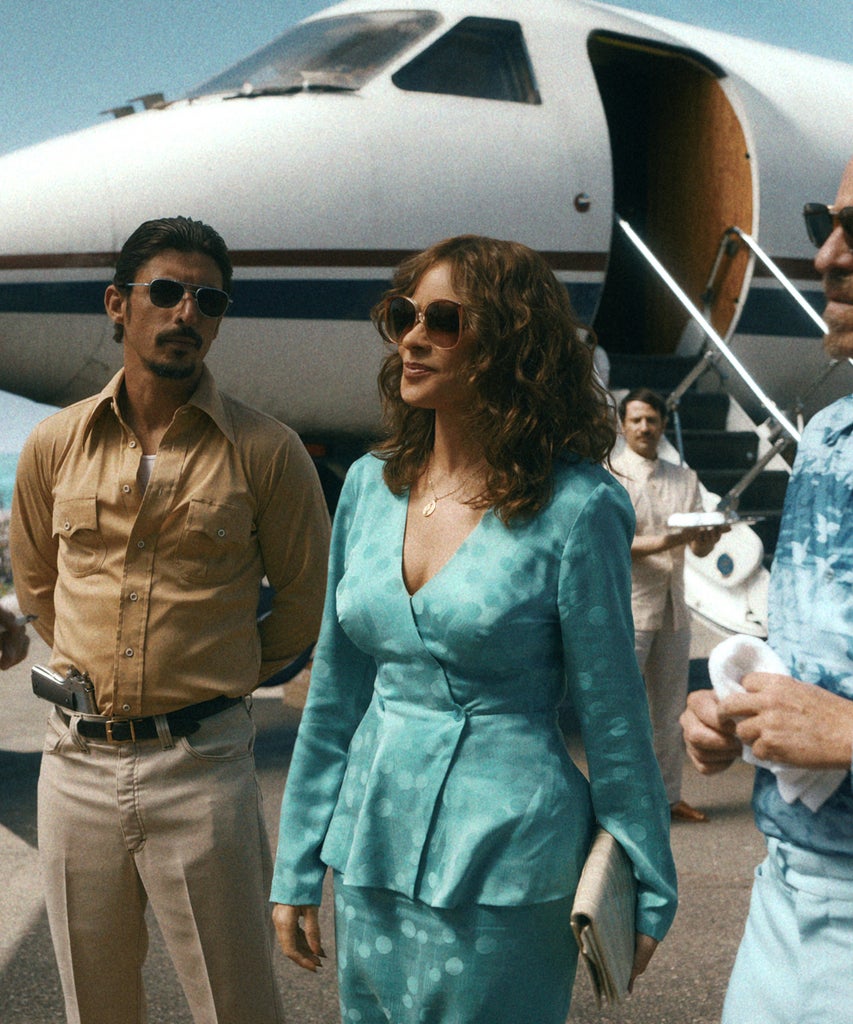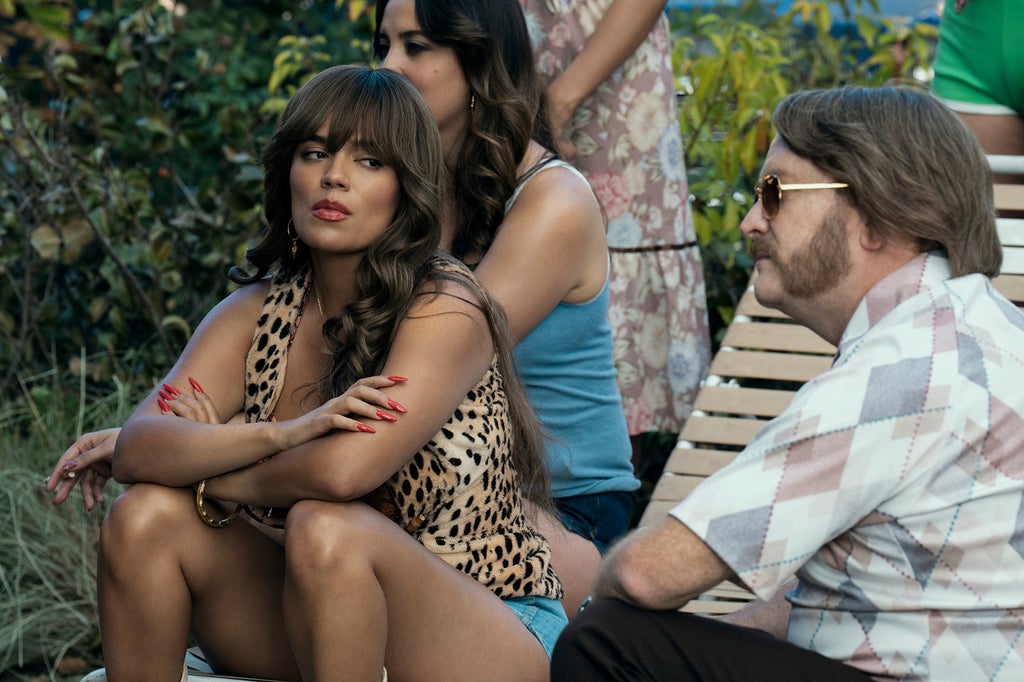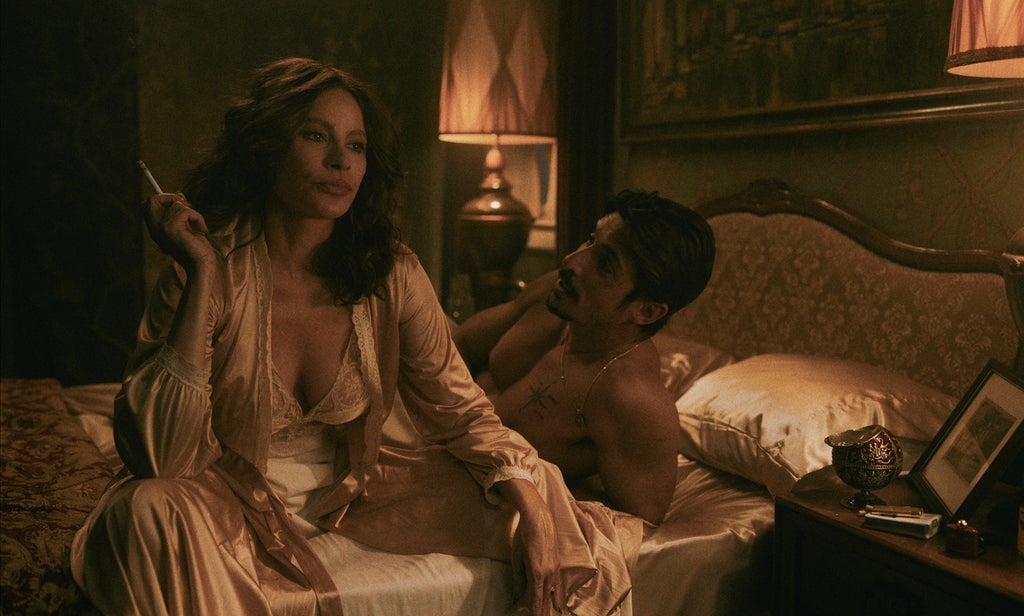
Real furs thrown over the shoulders; big, messy up-dos; cheetah and zebra print from head-to-toe; long French square manicures; and to complete it all, dark lips, smoky eyes, black leather, flashy designer bags, and ostentatious jewelry. Mob wife aesthetic flourished, as most fads seem to nowadays, on the ever-changing TikTok screen. As creator after creator showed how they interpreted this style on the app, Netflix launched Griselda, a six-episode series telling a fictionalized version of Colombian drug lord Griselda Blanco‘s life. Between both topics occupying real estate in pop culture, narco-glam seems to be having a moment. But as the Global North praises this aesthetic, there’s a disconnect from what narco culture can really mean.
Content creator Mikayla Toninato, who helped popularize the mob wife trend, called it “an attitude. It’s an aura. We all want to be the mob boss’s wife. We want big bold outfits. We are never extra enough. We want all the jewelry. We want to be covered in jewels.” A few days later, major media outlets jumped on mob wife glam, with articles defining the term and giving readers a way to achieve the look themselves. Like “quiet luxury” and “rockstar girlfriend,” these tiny but potent trends seem to be a byproduct of the times we live in. They spur suddenly, disperse like rushing torrents, and dissolve just as quickly. As these trends feverishly prevail — seducing and enticing the masses — they lose any sense of meaning. A Dazed article writes, “proximity to crime never looked so sexy.”
But in glamorizing crime aesthetics, we’re also romanticizing the violence that has — and continues to — breed havoc on innocent people, especially across Latin America, through physical brutality and violent stereotypes. In the 1990s, Pablo Escobar terrorized an entire country, blowing up commercial planes and public buildings. For years, when traveling abroad for any reason, Colombians dealt with being almost immediately associated with cocaine, war, terrorism, and drug lords. The country has attempted to change its public perception, but the stereotypes endure. Both Cartagena de Indias and Medellín contend with a predatory style of tourism that often involves men from the Global North who come looking for cocaine and “exotic” women. Some come to Medellín literally searching for “the Pablo Escobar” experience.
“Narco-glam seems to be having a moment. But as the Global North praises this aesthetic, there’s a disconnect from what narco culture can really mean.”
Vanessa Rosales Altamar
The fixation on narcos is in no way a novelty. Stories of power, violence, ferocious ascension, and crime attract people. And in Latin America, drug lords can use a rhetoric of social justice that feeds on the idea of “beating” U.S. imperialism by feeding its people coke or it can cater to the fable of rebellion and social mobility. In societies where inequality is so fierce, people may come to think of narcos as complex heroes of class disobedience.
“I think the major question to be considered in all of this is the why,” Edward Salazar, researcher, cultural critic, and PhD student at the University of California, tells Refinery29 Somos. “What sort of feelings, yearnings, anxieties do these stories materialize? Why do these stories, in which [we see] economic success, the overcoming of poverty, violence, the defiance of government, and legal institutional forces, generate such a fierce attraction? And how, in a country where the majority of the population lives in precarity, with little privileges and rights, do these narratives spark a deep affection?”

As fashion distorts mob culture, so do TV and film. Griselda, starring and produced by Colombian actress Sofía Vergara, takes place in the late 1970s and early 1980s in Miami. The story glamorizes cocaine orgies and the “innovative” and “visionary” streak that allegedly characterized Blanco in the business. You cannot remove Griselda from the significant array of similar productions made and consumed since the early 2000s. The 2015 series Narcos put the subject on a global stage. Before the recent rise in narco stories, we had Italian-American gangsters. But while a strong pop culture trope, it doesn’t define Italian Americans in real life. The same isn’t true for Latin Americans.
Omar Rincón, teacher, critic, and creator of the project Narcolombia, defines “narco” not just as an illicit and criminal activity but also about an aesthetic concept, a culture, one that reflects the mafia-like dynamics in both institutional government and illicit outsiders. It is a way of being — and being seen — in the world.
Sociologist Didier Correa, who has written vastly on the subject, explains that narcos act as tastemakers, even decorators, and that beyond their criminal activities, they also create a culture. We saw this play out with figures like Al Capone, who had a serious thing for exquisitely tailor-made suits, and with John Gotti’s lavish and pricy attire. While not entirely factual, Griselda also leans heavily into aesthetics, with gorgeous clothes and interior decoration seen throughout the series.
“How, in a country where the majority of the population lives in precarity, with little privileges and rights, do these narratives spark a deep affection?”
Edward Salazar
The very fact that these TV and film productions are so wildly successful is also because they are narco in that they make tons of money for everyone involved. However, demonstrations of “new money” are hardly an expression of Latin American men or women who wish to flaunt their newly acquired sense of power in the world. But it’s interesting to see how these dynamics play out when looked at in their context. Society perceived Italian-American gangsters in the 1030s as dangerous and threatening, their fabulous, whimsical suits in direct contradiction. They mostly conformed to a time when fashion was more homogenous and elegant, a time when men wore suits. But their flamboyant choices in color, fabric, or prints were also how they stood out and made the fashions of the time their own.
Meanwhile, narcos in 1980s Colombia came about during a time of maximalism and opulence galore, and they were creating hybrid imaginaries that brought in Mexican telenovelas, stories of insurrection, and their aspiration to display their own sense of elegance and glamor. Their flashy ways, which high-society folks and even politicians have judged, seem to have made their way to the mainstream, fitting perfectly into today’s flashy fashionability.
After all, mob wife aesthetic is conspicuous consumption. Both mobsters and narcos cater to a basic capitalist principle: You don’t just have money; you show it. So what’s the difference between the two groups? Probably the length of representation and the dimension of the stereotype. Also, the crudeness of the violence involved.

“The cultural narrative in this is highly attractive and fascinating, because it relates to the popular, to excess, extremity, exaggerated exhibition. It sears through our sense of modesty and galvanizes our voyeuristic side, through which we can see these forbidden worlds that are fascinating, spectacular,” Rincón tells Somos. “More so, narcos interpret the sense of taste and ethics of capitalism itself. I am self-made. I make myself. I am the one who deserves it all and that means consuming it all. I make money not just to have it but to participate in consumption and that means being flashy, being noticed, filling the world with my own set of images.”
Rincón makes an interesting point when he says that what was once deemed as “bad taste” has become the norm of our time. Isn’t former President Donald Trump a display of the ethics of narco culture? Isn’t the same true for Argentina’s Javier Milei and El Salvador’s Nayib Bukele? Is that not what the Kardashians have so astutely channeled? Is that not what soccer players do as well?
“Mob wife aesthetic may be just another fleeting interest in a world voraciously hungry to replace one thing with another, but narcocultura is an uncomfortable mirror of Latin American societies.”
VANESSA ROSALES ALTAMAR
The thorny glamor in narcocultura seems to carry a transversal element: perhaps the human urge to gaze upon excess, lawlessness, violence, the overcoming of precarity, the intricacies of crime. These are common narrative arches.
There is, however, a vile aftertaste when this culture serves as a mere digital gimmick or when it helps to support stereotypes of a “disorderly,” “savage” global south. Or when it becomes a fad that looks to feed an obsolete mode, which is what happens in the quest to find the next novelty in fashion.
In Latin America, it’s far more complex. No matter how disappointed many of us feel by the fact that Vergara would choose to play into this widely known stereotype, narcoculture in our context speaks of many other things — namely fables of social mobility, expressions for the human aspiration to money, power and its display. Mob wife aesthetic may be just another fleeting interest in a world voraciously hungry to replace one thing with another, but narcocultura is an uncomfortable mirror of Latin American societies.
Like what you see? How about some more R29 goodness, right here?

No comments:
Post a Comment